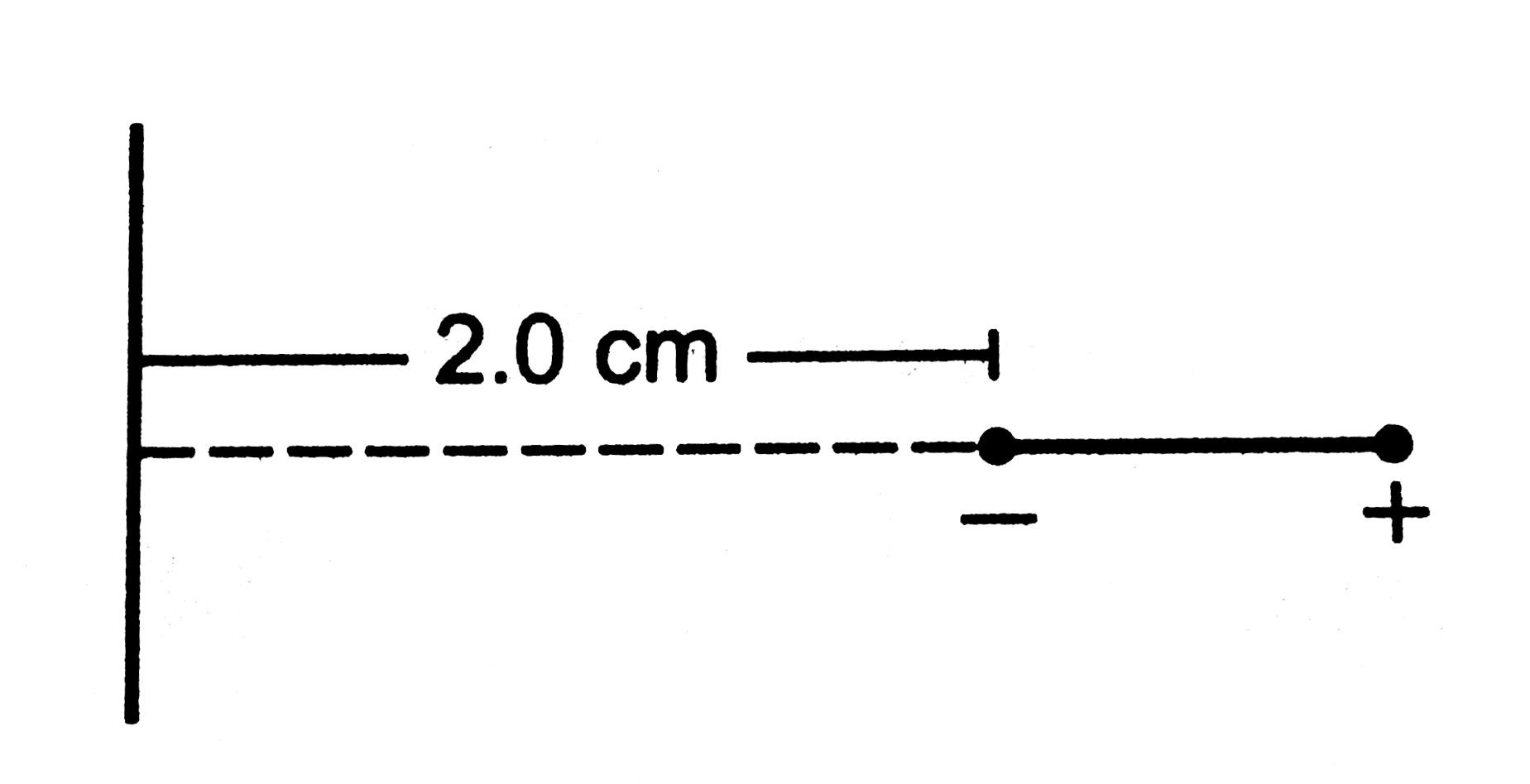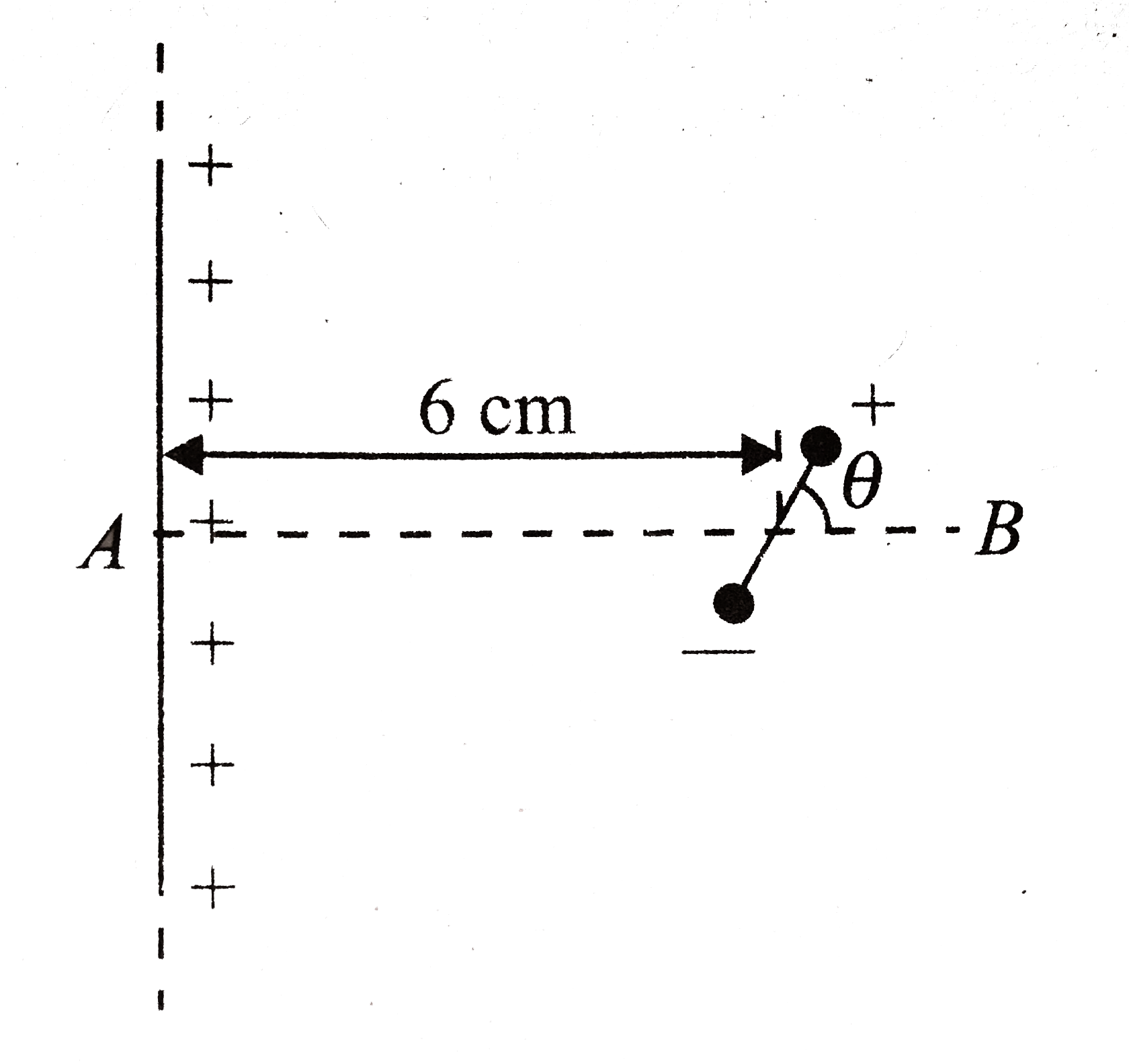An electric dipole consists of charges ±2.0×10−8C separated by a distance of 2.0×10−3 m. It is placed near a long line charge of linear charge density 4.0×10−4Cm−1 as shown in figure (30-W4), Such that the negative charge is at a distance of 2.0 cm from the line charge. Find the force acting on the dipole.

7.2 N towards the line charge
6.6 N away from the line charge
0.6 N away from the line charge
0.6 N towards the line charge.
The correct Answer is:D
The electric field at a distance r from the line charge of linear density λ is given by
E=λ2πε0r
Hence, the field at the negative charge, E1=(4.0×10−4)(2×9×109)0.02=3.6×108NC−1
The force on the negative charge,
F1=(3.6×108)(2.0×10−8)=7.2N towards the line charge
Similarly, the field at the positive charge,
i.e., at r = 0.022 m is E2=3.3×108NC−1.
The force on the positive charge,
F2=(3.3×108)×(2.0×10−8)=6.6N away from the line charge.
Hence, the net force on the dipole = 7.2N - 6.6N
=0.6N towards the line charge
Topper's Solved these Questions
- ELECTRIC CHARGES AND FIELDSBOOK - NCERT FINGERTPS ENGLISHCHAPTER - ELECTRIC CHARGES AND FIELDSEXERCISE - HOTS
8 Videos
- ELECTRIC CHARGES AND FIELDSBOOK - NCERT FINGERTPS ENGLISHCHAPTER - ELECTRIC CHARGES AND FIELDSEXERCISE - Higher Order Thinking Skills
7 Videos
- ELECTRIC CHARGES AND FIELDSBOOK - NCERT FINGERTPS ENGLISHCHAPTER - ELECTRIC CHARGES AND FIELDSEXERCISE - Gauss Law
9 Videos
- DUAL NATURE OF RADIATION AND MATTER BOOK - NCERT FINGERTPS ENGLISHCHAPTER - DUAL NATURE OF RADIATION AND MATTER EXERCISE - Assertion And Reason
15 Videos
- ELECTROMAGNETIC INDUCTIONBOOK - NCERT FINGERTPS ENGLISHCHAPTER - ELECTROMAGNETIC INDUCTIONEXERCISE - NCERT Exemplar
6 Videos
Similar Questions
An electric dipole consists of charges ±2.0×108C separated by a distance of 2.0×10−3 m. It is placed near a long ilne charge of linear charge density 4.0×10−4Cm−1 as shown in figure (30-W4), Such thet the negative charge is at a distance of 2.0 cm from the line charge. Find the force acting on the dipole.

View SolutionAn electric dipole consists of charges ±2.0×10−8 C separated by distance of ±2.0×10−3m. It is placed at a distance of 6 cm from a line charge of linear charge density 4.0×10−4Cm−1 as shown in figure such that the dipole makes an angle of θ=60∘ with line AB. Find the force acting on the dipole.

View SolutionAn electric dipole consisting of two opposite charges of 2×10−6C each separated by a distance of 3cm is placed in an electirc field of 2×105N/C. The maximum torque on the dipole is will be
View SolutionA spherical volume contains a uniformaly distributed charge of density 2.0×10−4Cm3. Find the electric field at a piont inside the volume at a distance 4.0 cm from the centre.
View SolutionAn electric dipole consists of two charges of 0.1μC separated bu a distance of 2.0cm. The dipole is placed in an external field of 105NC−1. What maximum torqur does the field exert on the dipole?
View SolutionFind the magnitude of the electric field at a point 4 cm away from a line charge of density 2×10−6Cm−1.
View SolutionA charged partical having a charge of −2.0×10−6C is placed close to a nonconducting plate having a surface charge density 4.0 xx 10^(-6) C m^(-2). Fine the force of attraction between the particle and the plate.
View SolutionTwo charges 4×10−9Cand−16×10−9C are separated by a distance 20cm in air. The position of the neutral point from the small charge is
View SolutionTwo charges 4×10−9and−16×10−9 C are separated by a distance 20 cm in air. The position of theh neutral point from the small charge is
View SolutionAn electric dipole consists of two opposite charges of magnitude 1μC separated by a distance of 2cm.The dipole is placed in an electric filled 10−5Vm−1.The maximum torque that the field exert on the dipole is
View Solution
